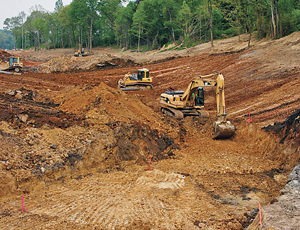An unstable and weak slime-like foundation was the primary factor behind the Dec. 22, 2008, catastrophic failure of a coal-ash pond at Tennessee Valley Authority’s Kingston plant near Knoxville, Tenn., says a root-cause analysis released last week by AECOM Technology Corp. TVA hired the firm after the accident to determine why dikes holding coal-waste slurry failed, flooding 300 acres around the plant and the Emory River with 5.4 million cu yd of coal ash.

Los Angeles-based AECOM’s analysis determined the dikes’ angle and setbacks, increased loads because of recent high fill and loose, wet ash contributed to the failure. But the main factor appears to be a 6-in. layer of very small, round-particle fly ash and silt at the bottom of the failed foundation that AECOM calls “slime.” AECOM’s findings were peer-reviewed by a member of the National Academy of Engineering.
AECOM’s findings do not denote preventive actions TVA could have taken. Separate analyses will be released later this month by TVA’s Inspector General’s office and the Tennessee Dept. of Environment and Conservation. TVA has hired Stantec Inc., Edmonton, Alberta, to assess coal-ash ponds at its other 11 plants. The firm is using the new findings to modify assessments, now 40% complete, says John Montgomery, senior principal.
But some engineers believe new analy- sis also is critical. Barry K. Thacker, a professional engineer and president of Knoxville-based Geo/Environmental Associates Inc., reviewed TVA public records and concludes the cause was deterioration of clay dike walls, which burst from increased slurry pressure. He says the structure could have been monitored and the event possibly prevented. His findings will be reviewed by state and federal regulatory agencies.
AECOM says the slime layer was created in the 1950s when fly-ash slurry, a byproduct of coal combustion, was allowed to run off into nearby Watts Bar Reservoir. TVA later built the coal-ash pond where the runoff occurred. Prior probing never identified the unstable slime-ash layer cited by AECOM.
Failure began as the ash pile reached 85 to 90 ft high in one pond cell, increasing load on slime at the foundation of the 50-ft-high dike, says AECOM. The failure created a domino effect, toppling several nearby dikes in less than an hour. “Static liquefaction of the ash did not cause the initiation of the failure, but was a consequence of an initial failure through the slime’s layer,” says the report.
Site cleanup managed by Pasadena, Calif.-based Jacobs Engineering could take years and cost $1 billion. Earlier this year, the U.S. Environmental Protection Agency began overseeing the work.
EPA now is probing all 427 U.S. coal-ash impoundments, including 44 at 26 powerplants identified on June 29 as having “high hazard potential.” These pose the highest risk to populations if impoundments fail. EPA is to propose regulation of coal-ash waste by year’s end.

Post a comment to this article
Report Abusive Comment